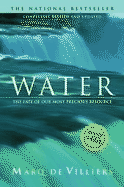Water: The Fate of Our Most Precious Resource

by Marq de Villiers
ISBN: 0771026412
Post Your Opinion | | A Review of: Water: The Fate of Our Most Precious Resource
by John AyreConsidering how crucial water is to life, it's surprising how few
books on water exist even today for the non-specialist. One celebrated
study, Marc Reisner's The Cadillac Desert has gone through several
editions but the focus there is on the water management and
depredations in the American southwest. Marq de Villiers's Water
which first came out in 1999, had a much broader perspective. It
carefully reviewed some major problems the world over, both technical
and political, in the seemingly simple task of making clean water
reliably come out of taps. It was an impressively detailed and
thought-out book and won the Governor General's Award for non-fiction.
Inevitably its success rather begged for an update and de Villiers
has obliged with a newly revised and expanded edition.
While the revision covers much the same territory as the first
edition, there has been a slight darkening of tone. Although the
first edition was a book full of stories of gross mismanagement and
pollution, de Villiers did at least indulge himself at the start
with an innocent Garden of Eden image. A South African transplanted
to Canada, de Villiers can never forget his grandfather's dry farm
on the edge of a desert. At his own recreational farm in central
Ontario, de Villiers has by contrast the luxury of a small spring
behind his barn where the water, seemingly inexhaustible and pure,
makes happy gurgling sounds. In the first edition, he even admitted
that at first he loved to sit near the spring and just experience
its plenitude. In the new edition he snatches this image away as
if it were a bit too clever or sentimental. In virtually any other
place in the world, after all, there would be farmers upstream
diverting water or polluting it.
Certainly there is no shortage of unhappy stories he can relate.
De Villiers provides a parade of international water disasters and
there are enough recent ones. The list in the new edition is almost
entirely different from that in his first book. One especially
depressing prediction from the United Nations suggests that in just
eleven years, 40% of the world's population will suffer major
difficulties in obtaining necessary water. Bankok is pumping so
much ground water out from beneath the city that like Mexico City,
it is slowly sinking in on itself. By 2050 Bangkok will be below
sea level. There are plenty of nightmare pollution stories in Water
as well, like the tons of mine tailings which spilled into a tributary
of the Danube ruining the whole riverway both for the fish and the
people living along it.
Using a chapter-by-chapter case study approach, de Villers reviews
some major problems in the international arena: The destruction of
the Aral Sea, attempts in various countries to pump out huge
repositories of ground water, the political and technical confusions
of managing the massive Tigris-Euphrates and Nile river systems,
and the smaller but no less thorny questions of water supply in
Israel and Palestine. The latter in particular is a microcosm of
what may happen everywhere in water-scarce areas where water could
become part of military strategy. Israeli determination, for instance,
to hold the Golan Heights is now at least one half of a story of
securing water supply.
One of the strengths of Water is de Villiers' ability to remain
rational and collected even as he outlines many frightening scenarios.
He appears to expect eventual solutions to both pollution and supply
problems. Political will is crucial, however, and sometimes inspired
action does occur. The Rhine River reached such a crisis level after
a major toxic spill that the Germans finally forced themselves to
clean it up. The destroyed riverway was clean enough to sustain new
fish stocks in just four years.
Throughout Water de Villiers suggests numerous ways of attacking
the other vexing problem of supply-many of them obvious, if painful.
If a region is furiously pumping out aquifers for irrigation water,
as had been happening for decades with the enormous Ogallala aquifer
of southcentral United States, then it's obviously necessary just
to halt the pumping by decommissioning land. De Villiers notes:
"Texas has already decommissioned nearly a million hectares,
one-third of its total irrigable land, and west Texas is almost in
panic mode...."
Less easy to resolve are the predicaments of large and rapidly
expanding desert cities like greater Phoenix (3 million people) and
Las Vegas (1.5 million). Thousand-mile pipelines or canals won't
solve the demand problem if there is no easy supply at the other
end. Even when a city virtually sits on an aquifer like Tampa, there
can be nightmarish complications. When Tampa pumped out water from
an aquifer close to the sea, salt water invaded the aquifer and the
city had to plan massive and very expensive desalination and reservoir
projects to provide fresh water for its growing population.
De Villiers twice returns to the image of his old Afrikaaner
grandfather coaxing water out of the earth with a rickety windmill
and then treating it as a precious-as-gold commodity to water his
crops. He even hand-watered his strawberry patch. He was successful
for decades but when a ranching company took the farm over after
he passed away, the land was destroyed and abandoned in just two
decades. There is a clear message in this concerning attitude. Care
and vigilance on the individual level will translate into solutions
to larger scale problems. Yet if the right values aren't taught and
encouraged at the grass roots level, the opposite prediction of
catastrophe is also true.
|